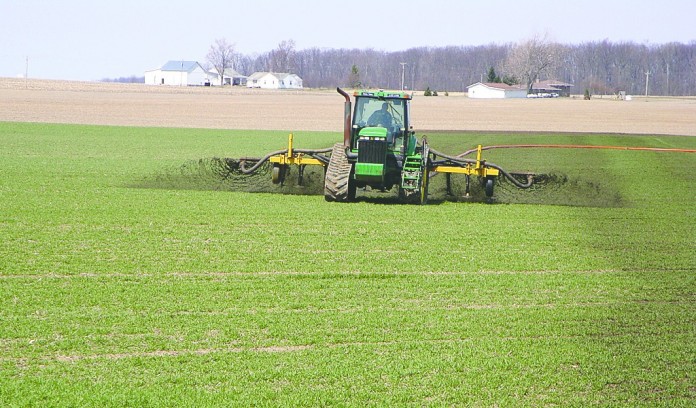
COLUMBUS — Liquid livestock manure can be a great option as a spring topdress fertilizer for wheat fields if applied during the appropriate window of time and if it has the right amount of nitrogen. In a report published in the latest issue of the Crop Observation and Recommendation Network (C.O.R.N) newsletter, experts said there is a window of time, usually around the last week of March or the first week of April, when wheat fields are firm enough to support manure-application equipment.
Additionally, by that time wheat fields have broken dormancy and are actively pulling nutrients from the soil. Glen Arnold, a field specialist in manure nutrient management systems with Ohio State Extension, said farmers thinking about a spring liquid manure application must first consider its nitrogen content.
Nitrogen varies
“Most manure tests reveal total nitrogen, ammonia nitrogen and organic nitrogen amounts,” Arnold wrote in the C.O.R.N. newsletter, published through the College of Food, Agricultural, and Environmental Sciences at The Ohio State University and available here.
“The ammonia nitrogen portion is readily available for plant growth. The organic nitrogen portion takes considerably longer to mineralize and generally will not be available when wheat uptakes the majority of its nitrogen in the months of April and May.” Nitrogen content varies depending on the type of manure used and the finishing buildings where it’s stored, Arnold said.
Wheat closeup
According to the report, most deep-pit swine finishing manure contains between 32 and 45 pounds of ammonia nitrogen per 1,000 gallons. Manure in finishing buildings with bowl waters and other water conservation systems has an ammonia nitrogen content closer to the higher end of this range, while manure in finishing buildings with fixed nipple waters and surface water occasionally entering the pit has less.
Dairy manure has also been tested for topdressing wheat fields as part of on-farm research trials. However, dairy manure contains far less ammonia nitrogen per 1,000 gallons than swine finishing manure and does not consistently produce wheat yields similar to commercial fertilizer, Arnold said. According to the trials, adding 28 percent urea ammonium nitrate to the dairy manure to increase its fertilizer value results in wheat yields similar to those achieved using commercial nitrogen.
Topdressing trials
In Ohio State’s wheat topdressing trials, manure ammonia nitrogen was applied at a rate similar to the nitrogen present in urea fertilizer, or about 100 pounds per acre. The manure was applied using a 4,800-gallon tanker with a Peecon toolbar 13.5 feet in width. This toolbar cuts the soil surface with a straight coulter, while a boot applies the manure over the soil opening. Researchers also made applications using Veenhuizen and Aerway toolbars. Results from three years of trials are summarized here.
Application standard
While all toolbars cutting through the soil used in manure application cause some disruption to the growing wheat, side-by-side comparisons with conventional surface-applied fertilizer have rarely shown any difference in yields, Arnold said. According to the report, another practice that is gaining acceptance is the application of manure to wheat by commercial dragline operators. This practice is faster and more efficient than tanker application and reduces the risk of soil compaction.
Arnold reminded growers and applicators that following the Natural Resources Conservation Service’s #633 Waste Utilization Standard is recommended when applying livestock manure to wheat to reduce potential environmental impacts. “These standards include a 35-foot-wide vegetative filter strip setback from ditches and streams,” Arnold wrote in the report.
“Applicators also need to look at the weather forecast to be certain there is not greater than a 50 percent chance of a half-inch of rain in the following 24 hours. Print this forecast out so you have proof in the event of a surprise downpour,” he said.
More information
Additional information regarding on-farm manure topdressing of wheat research trials can be found on the OSU Extension Agronomic Crops team’s website.











